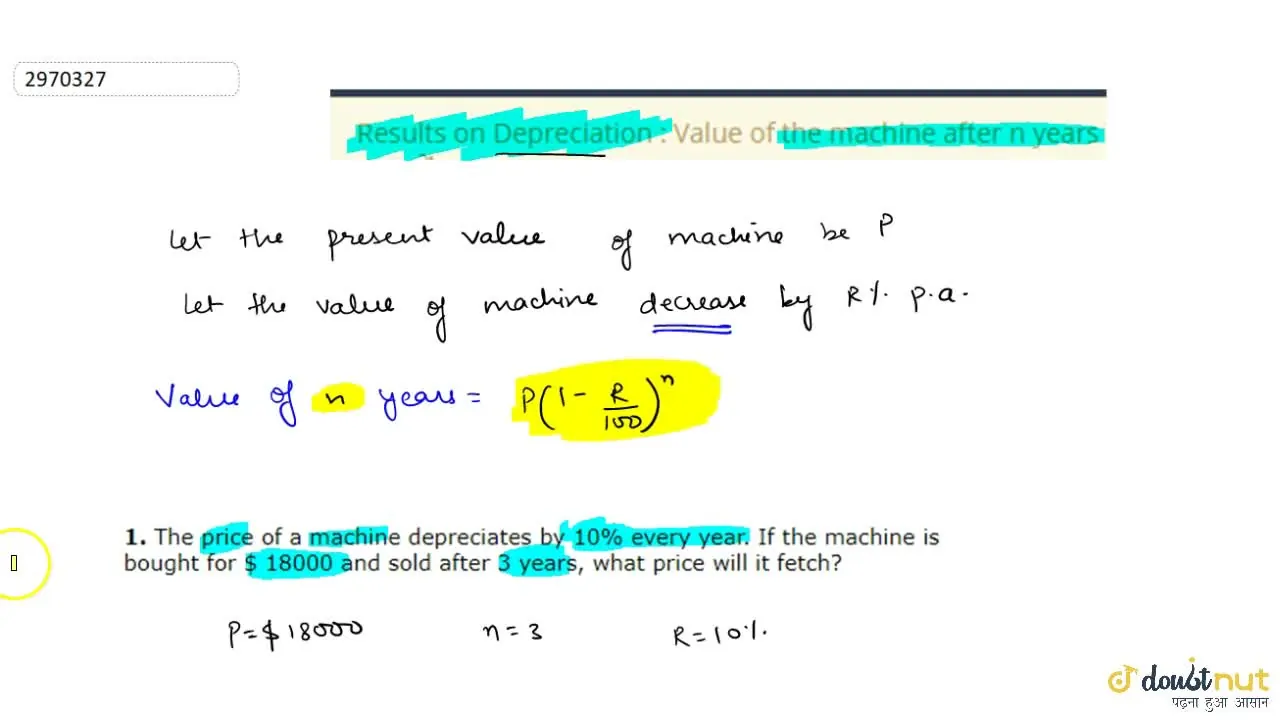Results on Depreciation : Value of the machine after n years किसी मशीन का मूल्य n सालों बाद
What is Depreciation?
Depreciation is characterized as the decrease in the cost of a fixed asset in a systematic way with a passage of time until the estimation of that asset becomes zero or minimal.
Fixed assets can be buildings, furniture, office hardware, machinery, and so on.. There is also a reverse of depreciation that is appreciation, which is an increase in the value of an asset over a period of time. On such example of appreciation is land, since it cannot be devalued as the estimation of land increases with time.
Characteristics of Depreciation
Following are the 3 chief features of depreciation:
- Depreciation is a decrease in the book estimation of fixed assets.
- Depreciation involves loss of estimation of assets because of the passage of time and obsolescence.
- Depreciation is a continuous process until the lifetime of assets.
Factors Causing Depreciation
Wear and Tear of the asset: Wear and tear is the deterioration of the item condition either due to extensive use or just by the passage of time. With wear and tear, the estimation of an asset gets decreased, resulting from its use in business operations for generating income.
Atypical Factors: Decline in the use of the asset might be caused by unusual factors. Specifically, accidents because of the fire, floods, earthquake and so on. Accidental loss is perpetual yet not proceeding.
Obsolescence: Obsolescence is another factor leading to the depreciation of fixed assets. In like manner language, obsolescence means being "obsolete". Obsolescence refers to a real asset getting obsolete because of the accessibility of a superior sort of asset.
Termination of Legal Rights: Some categories of assets lose their incentive after the agreement guiding their use in business operations that cease after the expiry of the predefined period.
Important Terms in Depreciation
Below mentioned are some terminologies that are necessary to understand the different types of depreciation approaches.
a. First Cost (FC) is the unadjusted cost of an asset. It is the initial or original cost of acquiring an asset.
b. Adjusted Cost Basis is the asset's original cost used to find depreciation deduction expenses adjusted by allowable increases or decreases.
c. Book Value (BV) is the original cost of the asset with all adjustments, excluding all allowable depreciation deductions.
d. Salvage Value (SV) is the residual value of an asset at the end of an asset's life.
e. Market Value (MV) is the amount of money paid to a seller by a buyer of an asset.
f. Usual life (n) is the projected period of an asset's life
Methods to Calculate Depreciation
Straight Line Method (SLM)
It is the simplest method to compute depreciation. It involves a simple allocation of a flat rate of depreciation every year over the useful life of the asset. The formula for straight-line depreciation is:
Annual Depreciation expense = (First cost (FC) – Salvage Value(SV)) / Useful life (n) of the asset
In the case of the depreciation Straight Line Method, a fixed depreciation sum is charged yearly, during the life cycle of an asset. The measure of yearly depreciation is registered on Original Cost, and it remains fixed from year to year. This technique is also known as the 'Original Cost strategy' or 'Fixed Installment technique'.
Declining Balance Method
In the case of the Declining Balance Method, depreciation is charged on the book value (cost – depreciation) of the asset consistently each year. Under this method, book value keeps on diminishing so, yearly depreciation also keeps on reducing. This method is also 'Reducing Installment Method'.
Depreciation Formula:

Related Videos:
- Concept of percentage
- Results on Population
- Value of the machine n years ago
- Population n years ago
- Certain value p increases by x% then increased value
- Certain value p decreased by x% then decreased value
Depreciation Solved Examples
Example 1: Apple Inc. purchased a machine for Rs 32,000 on January 1, 2019. The machine is expected to have a lifecycle of five years and no salvage value. The financial year ends on December 31. The straight-line method of depreciation is used. What will be the balance of the Accumulated Depreciation account on December 31, 2021?
Solution: Let us first find the balance of the accumulated depreciation at December 31, 2021. The period covered is 3 years (January 1, 2019, to December 31, 2020). The formula is:
Accumulated Annual depreciation=(Purchase price / Estimated useful life)×Period covered
Accumulated depreciation=(32,000/5)×3=19,200
The balance of accumulated depreciation at December 31, 2021, is Rs 19,200.
Example 2: A machine having a useful life of 4 years is purchased on January 1 2020. Cost of the asset is Rs 3,000 whereas its residual value is expected to be Rs 600. Compute the depreciation expense for the years ending June 30 2020 and June 30 2020.
Solution:.
Annual Depreciation expense = (3000 – 600)/ 4 years = Rs. 600 annually
-
Depreciation expense for the year ending June 30 2020:
600 x 6/12 = Rs 300
As Rs 600 that is calculated above represents the depreciation expense for 1 year (12 months,) as required in the problem, it has been reduced to 6 months to indicate the number of months the asset was actually accessible for use.
-
Depreciation expense for the year ending June 30 2021:
600 x 12/12 = Rs 600
Since the asset was available for the entire period, the annual depreciation expense is not allocated.
Example 3: A car was bought at Rs. 18000. If the car value declines by 2 % every year, what will be the value of the car after 2 months?
Solution: The initial value of the car is given Rs. 18000.
The rate of interest is at 2 % and the number of months( or the period covered) is 6.
Final Estimated Value = I X (1-r/100)n
n= 2 months, r = 2%
FE = 18000 x { 1 – (2/100)}2
=> 18000 x (0.98)2
=> 17287.2
The value of the car after 2 months will Rs 17287.2
Important Chapters:

Depreciation expense for the year ending June 30 2020:
600 x 6/12 = Rs 300
As Rs 600 that is calculated above represents the depreciation expense for 1 year (12 months,) as required in the problem, it has been reduced to 6 months to indicate the number of months the asset was actually accessible for use.
Depreciation expense for the year ending June 30 2021:
600 x 12/12 = Rs 600
Since the asset was available for the entire period, the annual depreciation expense is not allocated.
=> 18000 x (0.98)2
=> 17287.2
The value of the car after 2 months will Rs 17287.2
Similar Questions
Results on Depreciation : Value of the machine after n years किसी मशीन का मूल्य n सालों बाद
View SolutionThe value of a machine depreciates every year by 10%. If its present value is Rs 50.000 then the value of the machine after 2 years is _____
एक मशीन की कीमत हर वर्ष 10% घट जाती है। तदनुसार, यदि उसकी वर्तमान कीमत 50,000 हो, तो दो वर्षों बाद उस मशीन की कीमत कितनी रह जाएगी?View SolutionResults on Population : Population after n years n सालों बाद की आबादी
View SolutionValue of the machine n years ago किसी मशीन का मूल्य n सालों पहले
View SolutionThe cost of a sewing machine is Rs 7,000. Its value depreciates at 8% p.a. Then the value of the machine after 2 years is Rs 5,924.80.
View SolutionA manufacturer purchases a second hand machine for Rs. 60000 and spends some amount towards repairs thane its vaue goes up to Rs. 90000. If depreciation is 10% per annum, what will be the value of the machine after two years ?
View SolutionThe price of a shirt after 15% discount, is Rs 119. What was the marked price of the shirt before discount?
किसी कमीज का मूल्य 15% की छूट देने के बाद ₹ 119 है। छूट के पहले कमीज का अंकित मूल्य क्या था?View SolutionThe value on an article depreciates every year at the rate of 10% of its value. If the present value of the article is Rs.729, then its worth 3 years ago was
एक वस्तु के मूल्य में हर वर्ष उसके मूल्य के 10% की दर से ह्रास होता है। यदि का वस्तु का वर्तमान मूल्य रु729 है, तो 3 वर्ष पूर्व उसका मूल्य था-View SolutionA manufacturer purchases a second hand machine for Rs. 60000 and spends some amount towards repairs thane its vaue goes up to Rs. 90000. If depreciation is 10% per annum, what will be the value of the machine after two years ?
View SolutionResult 1 If V0 is the value of an article at a certain time and R% per annum is the rate of depreciation then the value Vn at the end of n years is given by Vn=V0(1−R1000)n
View Solution


